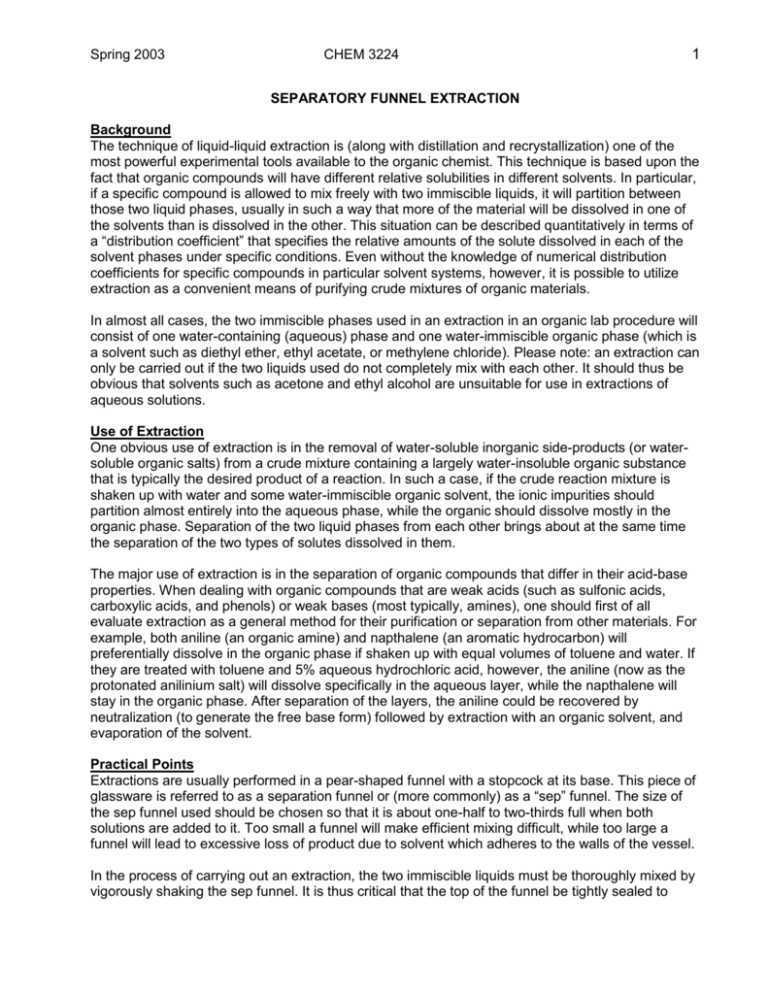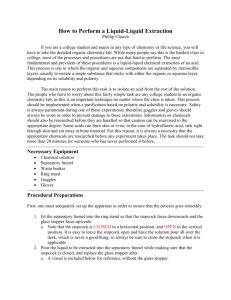SEPARATORY FUNNEL EXTRACTION
advertisement

Spring 2003 CHEM 3224 1 SEPARATORY FUNNEL EXTRACTION Background The technique of liquid-liquid extraction is (along with distillation and recrystallization) one of the most powerful experimental tools available to the organic chemist. This technique is based upon the fact that organic compounds will have different relative solubilities in different solvents. In particular, if a specific compound is allowed to mix freely with two immiscible liquids, it will partition between those two liquid phases, usually in such a way that more of the material will be dissolved in one of the solvents than is dissolved in the other. This situation can be described quantitatively in terms of a “distribution coefficient” that specifies the relative amounts of the solute dissolved in each of the solvent phases under specific conditions. Even without the knowledge of numerical distribution coefficients for specific compounds in particular solvent systems, however, it is possible to utilize extraction as a convenient means of purifying crude mixtures of organic materials. In almost all cases, the two immiscible phases used in an extraction in an organic lab procedure will consist of one water-containing (aqueous) phase and one water-immiscible organic phase (which is a solvent such as diethyl ether, ethyl acetate, or methylene chloride). Please note: an extraction can only be carried out if the two liquids used do not completely mix with each other. It should thus be obvious that solvents such as acetone and ethyl alcohol are unsuitable for use in extractions of aqueous solutions. Use of Extraction One obvious use of extraction is in the removal of water-soluble inorganic side-products (or watersoluble organic salts) from a crude mixture containing a largely water-insoluble organic substance that is typically the desired product of a reaction. In such a case, if the crude reaction mixture is shaken up with water and some water-immiscible organic solvent, the ionic impurities should partition almost entirely into the aqueous phase, while the organic should dissolve mostly in the organic phase. Separation of the two liquid phases from each other brings about at the same time the separation of the two types of solutes dissolved in them. The major use of extraction is in the separation of organic compounds that differ in their acid-base properties. When dealing with organic compounds that are weak acids (such as sulfonic acids, carboxylic acids, and phenols) or weak bases (most typically, amines), one should first of all evaluate extraction as a general method for their purification or separation from other materials. For example, both aniline (an organic amine) and napthalene (an aromatic hydrocarbon) will preferentially dissolve in the organic phase if shaken up with equal volumes of toluene and water. If they are treated with toluene and 5% aqueous hydrochloric acid, however, the aniline (now as the protonated anilinium salt) will dissolve specifically in the aqueous layer, while the napthalene will stay in the organic phase. After separation of the layers, the aniline could be recovered by neutralization (to generate the free base form) followed by extraction with an organic solvent, and evaporation of the solvent. Practical Points Extractions are usually performed in a pear-shaped funnel with a stopcock at its base. This piece of glassware is referred to as a separation funnel or (more commonly) as a “sep” funnel. The size of the sep funnel used should be chosen so that it is about one-half to two-thirds full when both solutions are added to it. Too small a funnel will make efficient mixing difficult, while too large a funnel will lead to excessive loss of product due to solvent which adheres to the walls of the vessel. In the process of carrying out an extraction, the two immiscible liquids must be thoroughly mixed by vigorously shaking the sep funnel. It is thus critical that the top of the funnel be tightly sealed to Spring 2003 CHEM 3224 2 prevent loss of the contents of the funnel; this requirement can present some problems. Greasing the stopper will give a good seal, but can lead to contamination of the product; failure to grease a glass stopper can lead to a “frozen” (or stuck) joint. Perhaps the best solution is to use a plastic stopper whenever possible. When shaking the funnel, it is good practice to vent the apparatus every few shakes to prevent the build-up of pressure in the vessel. This precaution is especially important when using volatile organic solvents (such as ether or methylene chloride) or when using aqueous solutions containing carbonate or bicarbonate (which often release carbon dioxide gas). Similarly, when using a sep funnel with a glass stopcock at its base, one must be sure that it is lightly greased before using it, so that the stopcock does not freeze. When the procedure is complete, the stopcock should be immediately disassembled and regreased to prevent it from drying out and freezing. A few other practical tips may be of some value to the novice chemist. Sep funnels are best hanged from rings of appropriate size (rather than clamps). These funnels will not drain well (if at all) if one fails to remove the stopper before opening the stopcock. Finally, it is usually best practice to keep the stopcock closed at all times except when one is draining the funnel – few things are more embarrassing in the lab than poring a solution of product through an open sep funnel onto the benchtop. Mathematical analysis (using the distribution coefficient) of various strategies for carrying out extractions clearly show that it is more efficient to carry out several extractions with a small amount of solvent rather than a single extraction with a large portion of one of the solvents, at least in those cases in which the compound in question has some reasonable degree of solubility in both the immiscible solvents used. For that reason, it is common to find literature procedures that include reaction work-up steps involving a series of several identical extractions or solvent “washes” (the extraction of one liquid with another is commonly referred to as a “wash”). It is usually a good idea to hold onto all of the solutions used in such a case until one has run through the entire procedure, so that the phase containing the desired component is not inadvertently thrown down the sink. Drying Agents If the compound desired has been purified by extraction, and ends up finally in some organic solution, the organic solvent will almost certainly be contaminated with significant amounts of water. In common practice, most of this water can be removed by complexation with inorganic drying agents. Magnesium sulfate is the most common of these drying agents; it is cheap, rapid in its action, and reasonably efficient in combining with water in these situations. When magnesium cannot be, sodium sulfate is used instead. Sodium sulfate is slower-acting in removing dissolved water, and does not change appearance on hydration as does the magnesium salt. Calcium chloride can complex low molecular weight alcohols as well as water. Drying agents are separated from the bulk solution by gravity filtration. Suction filtration using an aspirator causes the filtrate to cool as some of it evaporates, and the cold solvent can then condense some water from the aspirator “atmosphere,” rewetting the solution that had just been dried. Spring 2003 CHEM 3224 3 Experimental Procedure Follow the procedure outlined in your textbook and in this handout to carry out the separation of a mixture of m-toluic acid, p-anisidine, and diphenyl ketone, and the recovery of each of these compounds from the extraction solutions. Weigh out 0.5 g each of m-toluic acid, p-anisidine, and diphenyl ketone, set aside a minute amount (or obtain a minute amount in addition to the 0.5 g) for melting point, and place all three solids into an Erlenmeyer flask. Add 20 ml methylene chloride to the flask and stir the solution until all solids have completely dissolved, and transfer the resulting solution into a separatory funnel. Rinse the flask with an additional 20 ml methylene chloride, adding this “rinse” solvent to the solution already in the separatory funnel. Extraction of the acid: Wash the organic layer with two 20-ml portions of 5% aqueous sodium bicarbonate. Check the pH of the combined aqueous solutions. If the solution is NOT BASIC, perform another extraction with an additional 20 ml base. If the solution IS BASIC (excess sodium bicarbonate has been used) then set the solution containing the your desired product aside in a flask. Extraction of the base: Wash the organic layer (which now contains the base and the ketone) with two 20 ml portions of 10% aqueous hydrochloric acid. Check the pH of the combined aqueous solutions. If the solution is NOT ACIDIC, perform another extraction with an additional 20 ml acid. If the solution IS ACIDIC (excess hydrochloric acid has been used) then set the solution containing your desired product aside in a flask. Extraction of the ketone: Wash the organic layer (which now contains only the ketone) with two 20 ml portions of water. See “Dry organic layer” steps. Recovery of the acid: Taking the solution which contains your desired acid product, add 5 ml of 6N HCl to the flask. Check the pH of the solution, and continue to add HCl until the solution is acidic. Pour the resulting solution into a separatory funnel, add 20 ml methylene chloride, and follow typical procedures for extraction. Your “recovered” acid should now be found in the organic layer. Separate the organic layer, and wash it successively with two 20 ml portions of water. See “Dry organic layer” steps. Recovery of the base: Taking the solution which contains your desired base, add 5 ml of 2N NaOH to the flask. Check the pH of the solution, and continue to add NaOH until the solution is basic. Pour the resulting solution into a separatory funnel, add 20 ml methylene chloride, and follow typical procedures for extraction. Your “recovered” base should now be found in the organic layer. Separate the organic layer, and wash it successively with two 20 ml portions of water. See “Drying the organic layer” steps. Drying the organic layer: Transfer the resulting organic layer to a clean Erlenmeyer flask, dry for 5 to 10 minutes with anhydrous magnesium sulfate, filter, and concentrate under reduced pressure or leave in the hood to allow excess solvent to evaporate. Discard the aqueous layer. *RECORD ALL REQUIRED DATA IN LABORATORY NOTEBOOK; COMPLETE RESULTS, DISCUSSIONS AND CONCLUSIONS SECTIONS.






